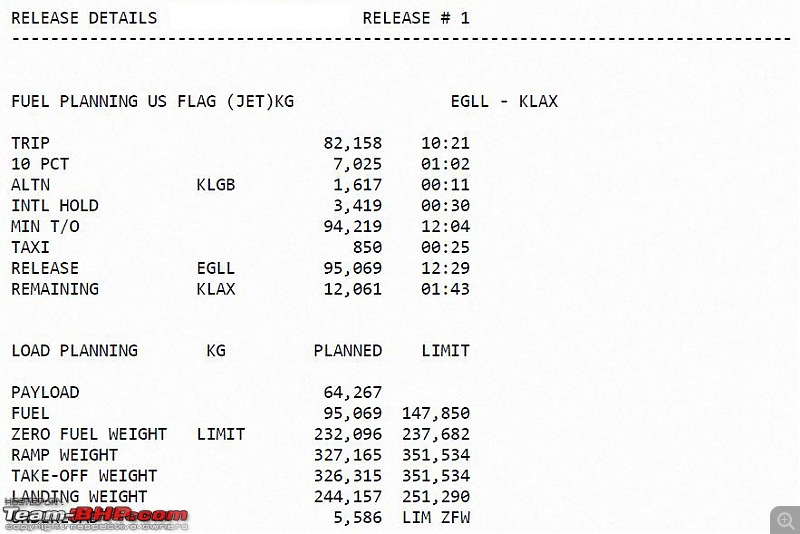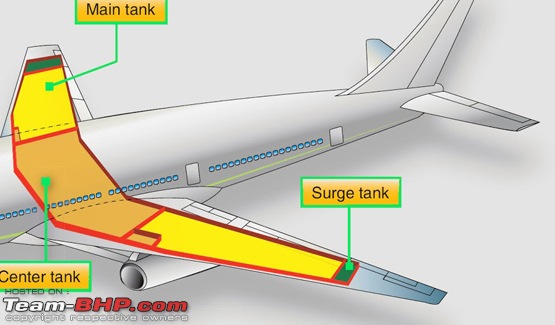Quote:
Originally Posted by maddy42  How much fuel a flight consumes in probably a 1 hour flight. I know it depends on the flight but just give us some examples. |
This is a very vague question, since it depends on a LOT of parameters. But since you want some ballpark figures, here we go. All values in kgs.
A320/B738/Any typical narrow body airliner - Assuming sea level, ISA conditions, idle fuel burn is around 540 kg/hr.
- Cruise fuel burn depends on so much, environmental conditions, cruise speed, altitude, weight, etc... but ballpark with a decent passenger load (total burn rates) for a B738 - 2,700kg/hr early in the flight (heavy) to 2400 kg/hr in cruise and reducing to 2,300kg/hr before descent.
Learjet 60XR- Assuming sea level, ISA conditions, idle fuel burn is around 320 kg/hr.
- Taxi: 350 kg/hr
- Cruise fuel burn 700 kg/hr
Boeing 777-300 ER - The big baby- Taxi Fuel Burn - GE Engines 2,000 kgs/Hour
- APU Fuel Burn - Ground consumption 240 kgs/hour - In-flight consumption 140-270 kgs/hour dependant on Altitude and Weight
- Cruise fuel consumption 8550 kg/hr during initial climb. Then it hovers around 8100 kg/hr for cruise phase. Descent rates are around 7750 kg/hr.
- The variation in fuel burn rates of the 777-300ER is high due to the fact that we have around 100,000 kgs of fuel on 10 hr+ routes.
Figure 1: This is the fuel plan for a B777-300ER from EGLL-KLAX. Notice the release fuel? Its around 95,000 kgs. By the time of landing, we will burn about 80,000 kgs(i.e around 12, 000 kg REMAINING at KLAX).

Quote:
Originally Posted by maddy42  Where is the fuel on a aircraft stored? Always confused due to the shape of the aircraft. |
Depends on the aircraft and its configuration. For eg. a 777-200LR with 3 Aux tanks has different fuel storage option compared to the normal config. Anyways, Fuel is usually stored in 3 tanks, the center(fuselage) and 2 wing tanks. The locations are shown below for a private jet(LR60) and a B777-300ER.
Figure 2: Fuel Tank locations B777-300ER  Figure 3: Fuel Tank locations Learjet 60XR
Figure 3: Fuel Tank locations Learjet 60XR  Figure 4:
Figure 4: This image is from the MFD(multi function display) of the 777-300ER. It shows the total amount of fuel as 102,000 kgs. Green rectangles are the fuel pumps, total of 6. Normally, the center tanks are emptied first and then wing tanks are used. Also, notice the cross feed valves. Generally, the Left fuel pumps supply fuel to left engine & vice versa. The crossfeed valve is used to temporarily connect the two sides of the system. This system allows the shortest route for the fuel and keeps the systems separate, so a leak on one side cannot drain the entire system. The crossfeed valve is generally kept shut for this reason. A || double line indicates a closed valve while a single line indicates a open valve.
.

Quote:
Originally Posted by maddy42  On a pvt jet do you have a separate terminal which saves you time getting to the airline? Also is there abundant parking area when you fly to a new airport? Is there parking fees etc and do you get a vehicle till your flight the way they show in movies?
Maddy |
Yes, most airports have a private terminal which allows us to skip long queues. For example Washington has the Signature terminal. Typically, you arrive at the 'FBO' (fixed base operator... essentially the private terminal) 20 mins before departure. They will take you to your plane in a golf cart (along with your luggage), or let you walk out (depends on the airport). I have very rarely used cars to out to the waiting jet. Total time from arriving at FBO to airborne? 5 to 10 minutes. Also, private jets can land at small airports closer to where you intend to travel. There are many more minor airports than major ones, so you often don't have to travel as far to get to one. And they're less congested, making the experience more pleasant.
Just FYI, I was informed by a friend of mine that GVK has stopped allowing private cars to ferry passengers up to their jets at CSIA, Mumbai. They have started their own service(i.e a Merc/Camry), which picks up passengers from Gate no 8 at CSIA and drops them near the jet. Its costs Rs. 10000 for a 2 minute, 200m trip .

. Even the Learjet cannot match upto their service's operating cost.
Quote:
Originally Posted by maddy42  How much time in advance do the pilots get notified on their next flight or are they on standby like a doctor? |
Pilots are people, not machines. They cannot fly 24x7. They need rest, time off for training, time off for family. I know people who call their pilots 2 hrs before leaving. I find that to be a be a very insensitive thing to do. At my organization, we usually have a policy of calling them 8 hrs to 10 hrs before leaving, so that they can rest, if they haven't already done so.
Quote:
Originally Posted by maddy42  5 this is my favorite one... Has anybody travelled on a Concorde? If so how was it?
|
Nopes, not lucky enough to get that opportunity.



 (8)
Thanks
(8)
Thanks


 (1)
Thanks
(1)
Thanks







 Do read up on Turkish airways crash that happened a couple of years back where the RA was faulty and the system went into FLARE/ RETARD mode while being a fair distance off the runway.
Do read up on Turkish airways crash that happened a couple of years back where the RA was faulty and the system went into FLARE/ RETARD mode while being a fair distance off the runway.



 . Even the Learjet cannot match upto their service's operating cost.
. Even the Learjet cannot match upto their service's operating cost.